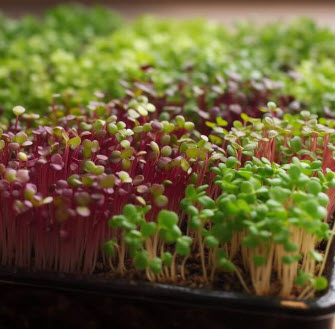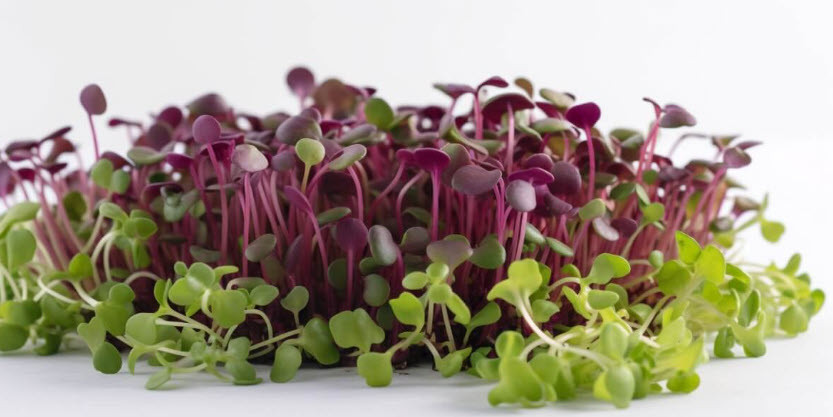Would you prefer to listen to a short podcast discussion about this article? Click on the audio below.
Are you looking to add some extra nutritional value to your meals? Look no further than microgreens! These tiny, yet mighty plants are taking the culinary world by storm with their impressive health benefits and delicious taste.
What Are Microgreens?
Microgreens are young plants that are harvested after just a few weeks of growth. They are smaller than baby greens, but bigger than sprouts, and are packed with nutrients. They come in a variety of flavours, including spicy, sweet, and sour, and can be used in a wide range of dishes, from salads to smoothies.
Why Are Microgreens So Nutritious?
Despite their small size, microgreens are packed with nutrients. In fact, some studies have shown that they contain up to 40 times more vitamins and minerals than their mature counterparts. They are also an excellent source of antioxidants, which can help protect your cells from damage caused by free radicals.
How Do You Grow Microgreens?
Growing your own microgreens is easy and requires very little space. All you need is a shallow tray, some potting soil, and some seeds. Simply fill the tray with soil, sprinkle the seeds on top, and mist with water. Place the tray in a warm, sunny spot, and in just a few weeks, you’ll have a tray full of delicious and nutritious microgreens.
Where Can You Find Microgreens in the UK?
Microgreens are becoming more and more popular in the UK, and can now be found at many farmers’ markets, health food stores, and even some supermarkets. They are also easy to grow at home, making them a great addition to any kitchen.

How Can You Use Microgreens in Your Cooking?
Microgreens are incredibly versatile and can be used in a wide range of dishes. Here are some recipe ideas to get you started:
- Add microgreens to your morning omelette for a nutritious breakfast
- Top your avocado toast with the greens for a fresh and healthy twist
- Use microgreens as a garnish for soups and stews
- Add them to your favourite sandwich for some extra crunch and flavour
- Mix them into your salad for a nutritional boost
- Blend them into your smoothies for a delicious and healthy drink
The possibilities are endless when it comes to using these incredible greens in your cooking. Experiment with different flavours and combinations to find your favourite way to enjoy these tiny nutritional powerhouses.
Check out our FREE book!
Final Thoughts
Microgreens may be small, but they pack a powerful nutritional punch. Whether you’re looking to add some extra flavour to your meals or simply want to boost your nutrient intake, they are a great choice. So why not give them a try today? Your body will thank you!
FAQ
What are microgreens?
They are young vegetable greens that are harvested at an early stage, typically within 7-21 days after germination, when the first set of true leaves appear.
How are they different from sprouts?
The plants are grown in soil or a soil substitute, whereas sprouts are grown in water and consumed with their roots. Microgreens are harvested above the soil level, while sprouts are consumed entirely.
Why are they considered nutritious?
Microgreens are packed with nutrients such as vitamins, minerals, and antioxidants. They often contain higher nutrient levels compared to their mature counterparts, making them a concentrated source of nutrition.
What are the most common types ?
Some common microgreens include sunflower, radish, broccoli, pea shoots, kale, arugula, cilantro, and basil. However, many vegetables and herbs can be grown as microgreens.
How long does it take to grow any of these plants?
The growth time varies depending on the type of plant but typically ranges from 7 to 21 days.
Can I grow them indoors?
Yes, they can be easily grown indoors using trays or containers placed near a window or under artificial lights.
What kind of container should I use?
Shallow trays or containers with drainage holes are commonly used. Plastic, ceramic, or food-grade trays can be used.
What type of soil should I use?
A lightweight and well-draining soil mix is recommended. You can use a commercial potting mix or create your own blend using materials like coco coir, vermiculite, and compost.
How often should I water my crop?
They require consistent moisture, so it’s important to water them regularly. Aim to keep the soil evenly moist, but not waterlogged. Watering once or twice a day is usually sufficient.
Do the plants require sunlight?
They do require light to grow, but direct sunlight is not always necessary. They can be grown under natural light near a window or under artificial grow lights.
Can I use artificial light for growing?
Yes, artificial grow lights such as fluorescent, LED, or full-spectrum lights can be used to provide adequate light for growing indoors.
How do I harvest my rop?
Microgreens are typically harvested by cutting them just above the soil level using clean scissors or a sharp knife. Harvest when the first true leaves have developed.
Can I eat them raw?
Yes, they are commonly consumed raw. They can be used as a garnish, added to salads, sandwiches, wraps, and smoothies, or used in various other culinary applications.
What are some popular ways to use the plants in recipes?
They can be used to add flavour, texture, and visual appeal to a wide range of dishes. They can be sprinkled on top of soups, omelettes, and pizzas, or incorporated into salads, stir-fries, and sandwiches.
How do I store a harvested crop?
It’s best to consume microgreens immediately after harvest for the freshest taste and highest nutrient content. If storing, gently wash and pat them dry, then store them in a breathable container or plastic bag in the refrigerator.
How long can I keep microgreens in the refrigerator?
They are best consumed within a few days of harvest for optimal freshness. However, if stored properly, they can last for up to a week in the refrigerator.
Are there any common pests or diseases that affect microgreens?
Yes, some common pests include aphids, fungus gnats, and spider mites. Proper sanitation, good airflow, and using sterile soil can help prevent pest and disease issues.
Can I reuse the soil after harvesting microgreens?
It is generally recommended to use fresh soil for each microgreen crop to prevent the risk of diseases and ensure healthy growth. Reusing soil can increase the likelihood of pathogens or nutrient imbalances.
How do I prevent mould or fungal growth on microgreens?
To prevent mould or fungal growth, ensure proper airflow, avoid overwatering, and use clean trays and utensils. Applying a diluted hydrogen peroxide solution or a natural fungicide can also help prevent mould.
Are microgreens suitable for hydroponic or aquaponic systems?
Yes, microgreens can be grown hydroponically or in aquaponic systems where the roots are suspended in nutrient-rich water. However, it requires specific equipment and knowledge of hydroponic or aquaponic growing methods.
………………………………………………………………………………………….
Here is an excellent infographic that may help you.

If you need any further information or assistance with this article, don’t hesitate to Contact Us




















